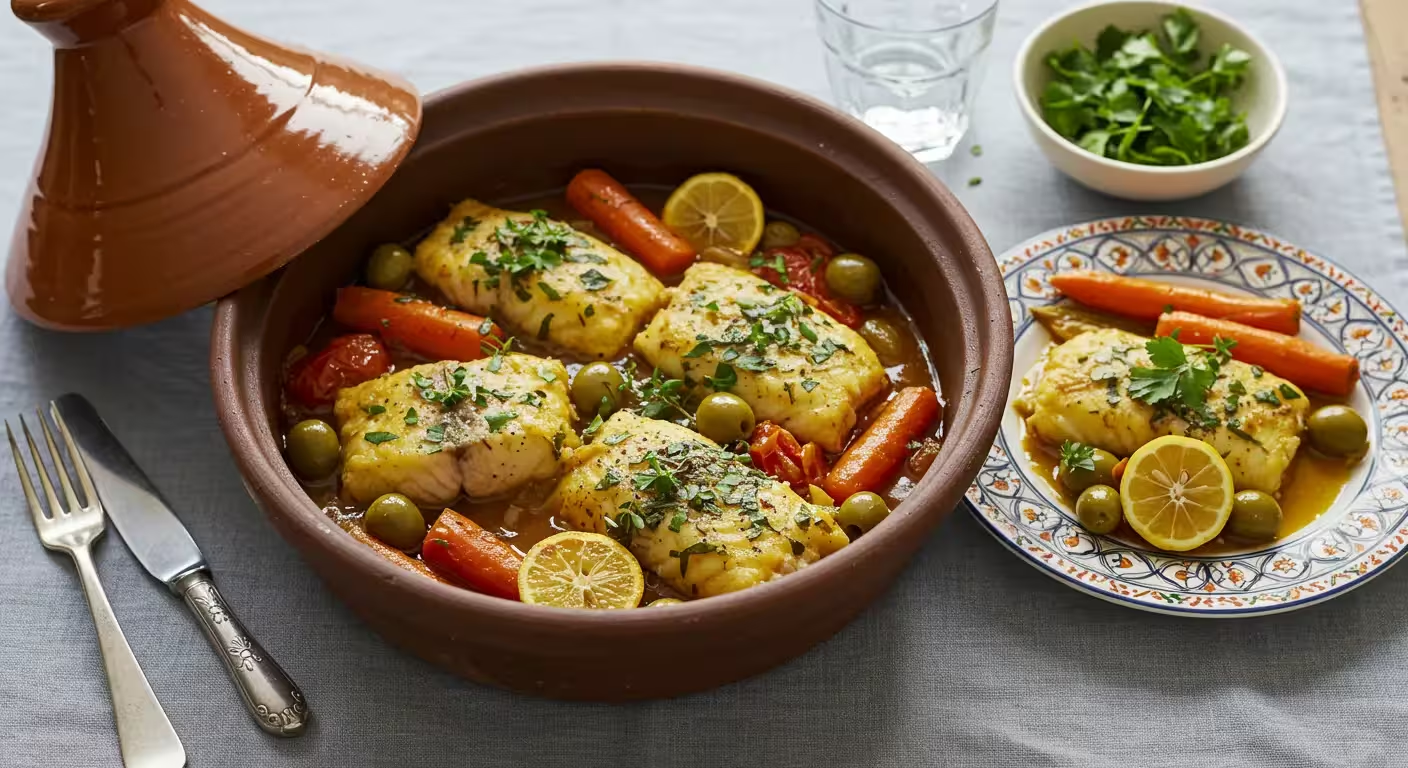Table of Contents
🌊 Discover the Magic of Moroccan Whiting Fish Recipes
Moroccan cuisine is a treasure trove of flavors, colors, and aromas that captivate food lovers around the globe. Rooted in centuries of cultural exchange and rich culinary traditions, Moroccan dishes are known for their perfect balance of sweet, savory, and spicy notes.
Learn more about the UNESCO-recognized culinary heritage of Morocco and its global significance.
At the heart of this cuisine lies the iconic tagine, a dish named after the earthenware pot it’s cooked in. The tagine’s unique shape and slow-cooking method allow flavors to meld beautifully, resulting in dishes that are both comforting and deeply satisfying.
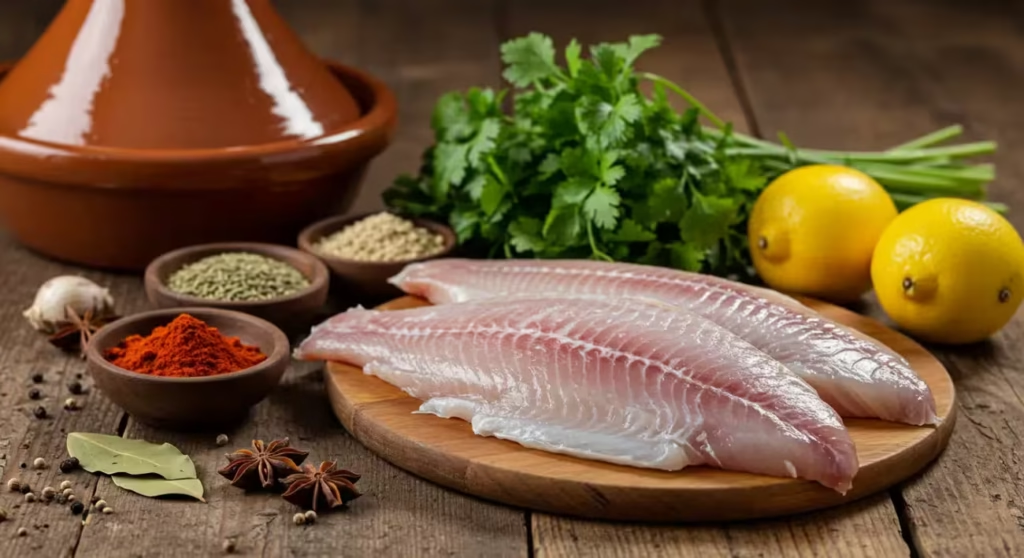
Among Morocco’s diverse culinary offerings, the fish tagine holds a special place. This dish brings together the freshest ingredients, fragrant herbs, warm spices, and vibrant vegetables, into a wholesome meal that’s as healthy as it is delicious. When paired with whiting fish recipes, a mild and tender variety, the tagine becomes an excellent choice for anyone seeking a flavorful, protein-packed dish that’s easy to prepare and enjoy.
Whiting fish is not only rich in omega-3 fatty acids but also low in calories, making it a fantastic option for those who want to indulge in healthy eating without compromising on taste.
Looking for more healthy Moroccan seafood ideas? Try our flavorful Chermoula Fish Tagine Recipe for another delicious option.
In this blog post, I’ll guide you through the steps to create a mouthwatering Moroccan fish tagine with Chermoula, a traditional marinade that’s the secret behind the dish’s irresistible flavor. Whether you’re new to Moroccan cuisine or a seasoned cook looking to expand your repertoire, this recipe will help you bring a piece of Morocco to your dining table. Get ready to embark on a culinary journey that’s equal parts comforting and exotic, with a dish that’s sure to impress your family and friends.
Let’s dive into the art of making this zesty Moroccan feast with whiting fish recipes!
🍲 What Makes Moroccan Fish Tagine Special?
🍽️ The Magic of the Tagine Cooking Method
The tagine isn’t just a pot; it’s a culinary tradition steeped in Moroccan heritage. This iconic clay or ceramic vessel is uniquely designed with a conical lid that allows steam to circulate as the dish cooks. The result? Tender ingredients infused with rich, concentrated flavors. Slow cooking in a tagine is more than a technique, it’s an art form. By gently simmering fish, vegetables, and spices over low heat, this method ensures that every ingredient contributes to a harmonious medley of tastes.
🧭 Discover another beloved tagine dish in our Ultimate Moroccan Fish Balls Tagine Recipe.
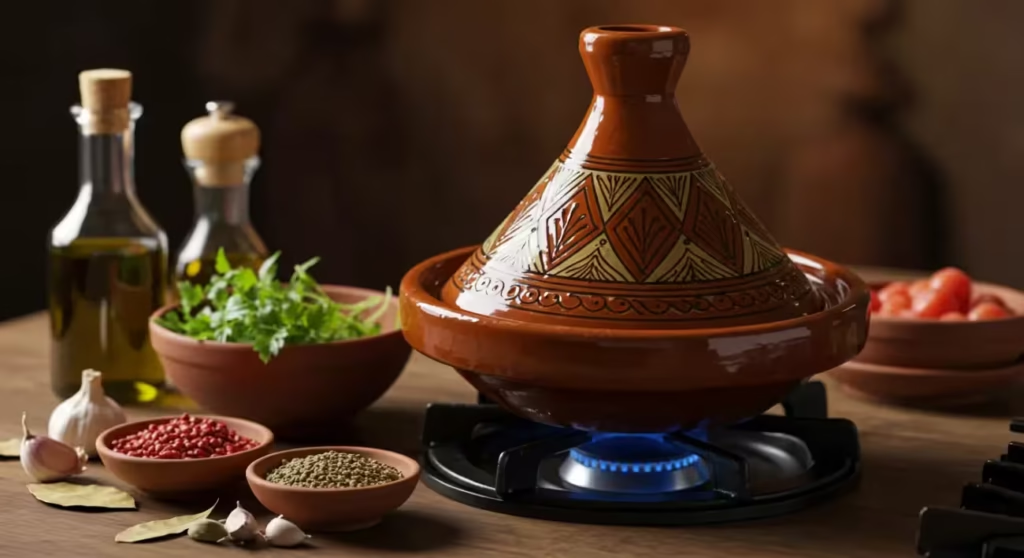
What sets tagine cooking apart from other methods is how it preserves moisture and enhances natural flavors. The fish remains succulent, the vegetables retain their texture, and the spices meld into an aromatic symphony that fills your kitchen with warmth. If you’ve never cooked with a tagine before, this dish is the perfect introduction to its wonders. And don’t worry, if you don’t have a tagine, a heavy-bottomed skillet or Dutch oven can still work beautifully.
📚 Learn more about traditional Moroccan cookware on TasteAtlas.
🌿 Chermoula: The Heart of Moroccan Fish Dishes
If the tagine is the soul of Moroccan cooking, Chermoula is undoubtedly its heartbeat. This vibrant marinade is what transforms a simple piece of fish into an explosion of flavor. Chermoula is a blend of fresh herbs, earthy spices, and zesty citrus, coming together to create a paste that’s packed with personality.
The key ingredients in Chermoula include parsley, cilantro, garlic, paprika, cumin, and a generous splash of olive oil. For a citrusy kick, fresh lemon juice or preserved lemons are added, bringing a tangy brightness that complements the fish perfectly. Some variations even include chili or harissa for those who love a bit of heat.
When the fish is coated with this aromatic mixture, it absorbs all the flavors while staying moist and tender. In Moroccan cuisine, Chermoula isn’t just reserved for fish, it’s also used to marinate chicken, lamb, or vegetables. But when paired with whiting fish in a tagine, it creates a dish that’s hard to beat.
🥕 Fresh, Vibrant Ingredients
One of the most appealing aspects of Moroccan fish tagine is its celebration of fresh, wholesome ingredients. This dish brings together the best of the Mediterranean pantry, highlighting herbs, vegetables, and spices in their freshest form.
For the vegetables, you’ll often find a mix of potatoes, carrots, tomatoes, and bell peppers. These ingredients not only add color to the dish but also soak up the flavors of the Chermoula and cooking juices, making every bite delightful. Preserved lemons, a staple in Moroccan cuisine, add a unique tanginess that elevates the dish to a whole new level.
On the spice front, you’ll encounter warming blends of paprika, cumin, turmeric, and sometimes a pinch of saffron. These spices are balanced with the freshness of parsley and cilantro, creating a dish that’s aromatic and comforting. The use of olive oil ties everything together, adding richness without being overpowering.
The beauty of Moroccan fish tagine lies in its simplicity and versatility. By using high-quality, fresh ingredients, you can recreate this authentic dish at home and enjoy the flavors of Morocco in every bite. Whether you’re preparing it for a special occasion or a cozy family dinner, this dish is sure to leave a lasting impression.
Ready to bring this flavorful tradition to your kitchen? Let’s move on to the ingredients you’ll need to create your own Moroccan whitng fish recipes!
🧂 Ingredients You’ll Need for Tagine Whiting Fish Recipes
🐟 Fresh Whiting Fish: Why It’s Perfect for This Dish
Whiting fish recipes is the star ingredient of this Moroccan tagine recipe, and for a good reason. Its delicate, flaky texture and mild flavor make it an excellent canvas for the bold and vibrant spices of Moroccan cuisine. Whiting fish cooks quickly and absorbs the flavors of the Chermoula marinade beautifully, ensuring each bite is tender and infused with aromatic goodness.
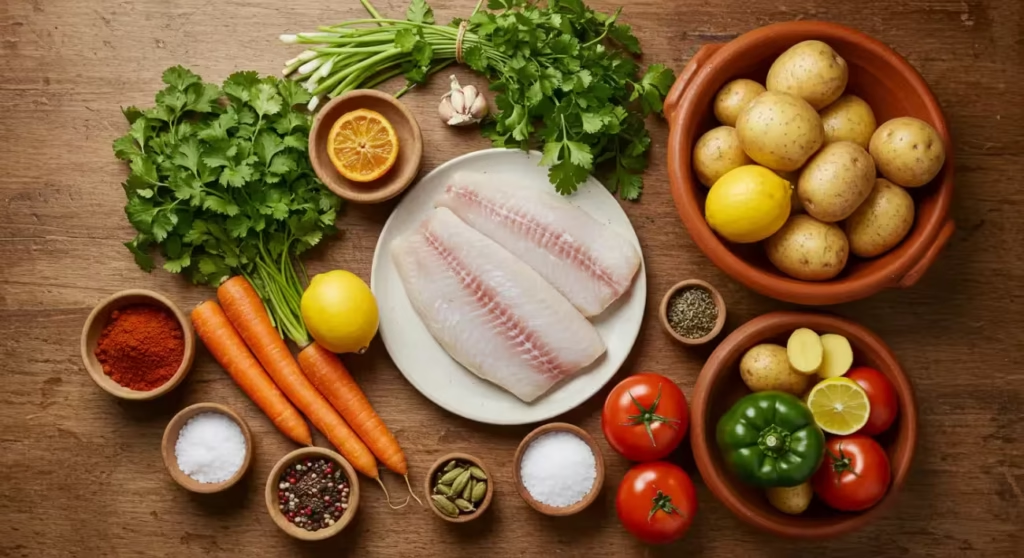
If fresh whiting fish is unavailable in your area, don’t worry, there are plenty of substitutes you can use. Cod, haddock, or tilapia are great alternatives that share a similar mild taste and flaky texture. If you prefer a slightly richer flavor, you can also opt for halibut or sea bass. The key is to choose a fish that holds up well during cooking and doesn’t overpower the spices and vegetables in the dish.
🌿 Essential Spices and Herbs
No Moroccan dish is complete without its signature spices, and a fish tagine is no exception. These spices not only add depth of flavor but also bring warmth and aroma to the dish:
- Paprika: Sweet and smoky, it forms the base of the spice blend, adding a subtle richness to the marinade.
- Cumin: This earthy spice is a staple in Moroccan cooking and pairs perfectly with fish.
- Coriander: With its citrusy undertones, coriander enhances the freshness of the dish.
- Parsley and Cilantro: These fresh herbs are key components of Chermoula, adding brightness and a herbal kick.
Using fresh herbs and high-quality spices is essential for achieving authentic Moroccan flavors. If possible, toast and grind whole spices at home for an extra burst of aroma and taste.
🧄 The Chermoula Marinade: Step-by-Step Preparation
The vegetables in a Moroccan tagine whiting fish recipes are more than just a side, they’re integral to the dish, adding texture, color, and a natural sweetness that balances the spices. Here’s what you’ll need:
- Potatoes: Starchy and satisfying, they soak up the flavorful juices of the tagine, making them irresistibly delicious.
- Tomatoes: Fresh or canned tomatoes create a rich, tangy base for the dish, enhancing the overall depth of flavor.
- Carrots: Their natural sweetness provides a subtle contrast to the tangy preserved lemons and spices.
- Preserved Lemons: A quintessential ingredient in Moroccan cooking, preserved lemons add a unique, tangy-salty flavor that’s hard to replicate.
You can easily adjust the choice of vegetables to suit whatever you have available in your kitchen. Bell peppers, zucchini, or even green beans can be excellent additions to your tagine.
🧄 The Chermoula Marinade: Step-by-Step Preparation
Chermoula is the heart and soul of this dish, and making it from scratch is easier than you think. Here’s a simple step-by-step guide to preparing this vibrant marinade:
- Gather Your Ingredients: You’ll need fresh parsley, cilantro, garlic, paprika, cumin, coriander, olive oil, and lemon juice or preserved lemons. Optional: a pinch of chili flakes or harissa for a spicy kick.
- Chop the Herbs: Carefully mince the parsley and cilantro into small, fine pieces. A sharp knife works best to retain their fresh aroma.
- Crush the Garlic: Use a mortar and pestle or a garlic press to crush the garlic into a smooth paste.
- Mix the Marinade: In a bowl, combine the chopped herbs, garlic, and spices. Add olive oil and lemon juice, stirring until the mixture forms a thick, vibrant paste. Adjust seasoning to taste.
- Marinate the Fish: Coat the fish generously with the Chermoula, ensuring every piece is well-covered. Let it marinate for at least 30 minutes, or up to a few hours for deeper flavor.
Chermoula isn’t just for fish, it’s a versatile marinade that can be used for chicken, vegetables, or even tofu. Once you’ve mastered this blend, you’ll find yourself reaching for it again and again.
With these fresh, wholesome ingredients and the magic of Chermoula, you’re ready to create a tagine that’s bursting with authentic Moroccan flavors. Let’s move on to the step-by-step process of bringing it all together!
👉 If you’re curious how Chermoula works in other Moroccan dishes, check out our flavorful Zesty Moroccan Meatballs recipe. And to dive deeper into the tradition behind this classic marinade, explore Saveur’s guide on Chermoula.
🥘 Step-by-Step Guide to Preparing Moroccan Tagine Whiting Fish Recipes
Cooking a Moroccan whiting fish tagine is a rewarding process that combines preparation, layering, and patience. Each step builds on the last to create a dish full of vibrant flavors and textures. Follow this detailed guide to bring the essence of Morocco to your table.
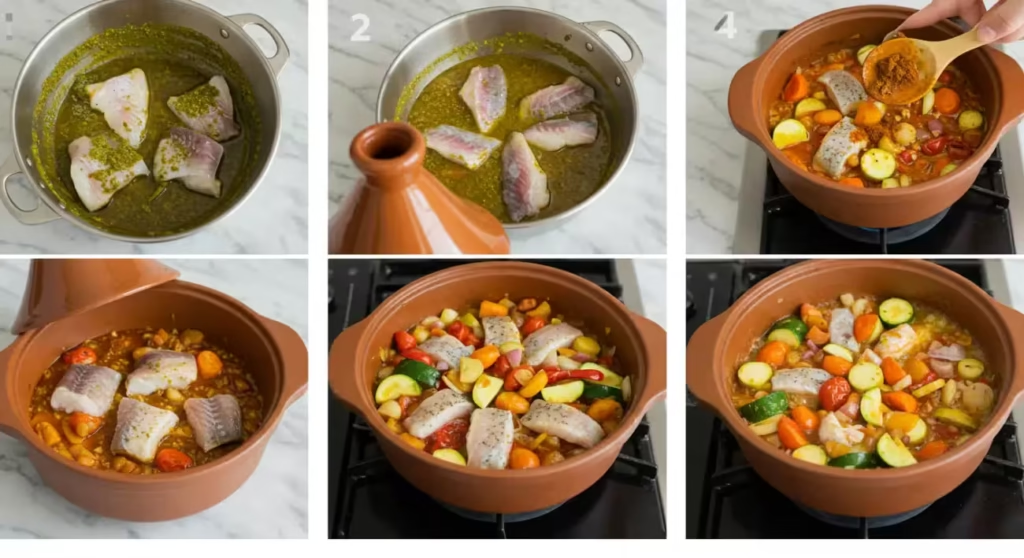
🐟 Step 1: Marinating the Whiting Fish
The secret to a flavorful tagine lies in the Chermoula marinade, which transforms the delicate whiting fish into an aromatic masterpiece. To begin:
- Prepare the Chermoula: In a bowl, combine finely chopped parsley and cilantro, crushed garlic, paprika, cumin, coriander, olive oil, and freshly squeezed lemon juice (or diced preserved lemons for a more traditional twist). Stir until it forms a thick, aromatic paste. For a spicier kick, you can mix in a pinch of chili flakes or harissa.
- Coat the Fish: Place the cleaned and dried whiting fish fillets in a shallow dish. Generously rub the Chermoula onto both sides of the fish, ensuring an even coating. This marinade not only flavors the fish but also tenderizes it as it soaks in the spices.
- Let It Rest: Cover the dish and refrigerate the marinated fish for at least 30 minutes. If time allows, let it sit for up to 2 hours to fully absorb the flavors.
Pro Tip: Don’t skip the marination step, it’s what makes the fish deeply flavorful and ensures it doesn’t lose its texture during cooking.
🧅 Step 2: Layering Ingredients in the Tagine
A Moroccan tagine is all about layering ingredients for even cooking and maximum flavor infusion. If you’re using a traditional tagine pot, ensure it’s been preheated and seasoned correctly.
- Prepare the Base: Drizzle a generous amount of olive oil into the base of the tagine pot to prevent sticking and enhance richness.
- Add Vegetables: Begin with a layer of sliced potatoes, forming a circular pattern. Follow with a layer of carrots and tomatoes. Sprinkle each layer with a light seasoning of salt, paprika, and cumin to build flavor from the bottom up.
- Place the Fish: Gently lay the marinated whiting fish fillets over the vegetables. Pour any remaining Chermoula from the marination dish over the fish to ensure every last bit of flavor is included.
- Top It Off: Add additional toppings like preserved lemon slices, green or black olives, and thinly sliced bell peppers for a pop of color and a tangy-salty burst.
Pro Tip: Arrange the ingredients with care, Moroccan dishes are as much about presentation as they are about flavor.
🔥 Step 3: Slow Cooking for Maximum Flavor
The magic of the tagine comes to life during the slow cooking process. This allows the spices, fish, and vegetables to meld into a rich and aromatic dish.
- Cover and Cook: Place the lid on your tagine pot and set it over low to medium heat. If using a stovetop, use a diffuser under the tagine to distribute heat evenly and prevent cracking.
- Monitor the Heat: Let the tagine cook slowly for about 40 to 50 minutes. Avoid lifting the lid too often, as this releases the steam needed to keep the dish moist.
- Check for Doneness: The fish should be tender and flaky, and the vegetables should be soft but not mushy. If needed, adjust the cooking time slightly depending on the size and thickness of the fish fillets.
Pro Tip: If the dish looks dry during cooking, add a splash of water or stock to maintain moisture without diluting the flavors.
🍽️ Optional Tips for Serving
Once your tagine is ready, it’s time to serve it in a way that elevates the dining experience:
- Garnish Thoughtfully: Sprinkle freshly chopped parsley or cilantro on top for a burst of color and freshness. Add a few slices of fresh lemon or preserved lemon for a tangy finish.
- Serve Traditionally: Moroccan fish tagine is best enjoyed with fluffy couscous or warm, crusty bread to soak up the flavorful sauce. A side of Moroccan salad, made with cucumbers, tomatoes, and a light vinaigrette, pairs beautifully with the dish.
- Adjust to Taste: Offer your guests extra olives, harissa, or lemon wedges on the side so they can customize their portions to their liking.
Pro Tip: Serve the tagine straight from the pot for an authentic Moroccan dining experience. The sight and aroma of the dish will captivate your guests before they even take a bite.
By following these steps, you’ll master the art of Moroccan tagine whiting fish that’s bursting with authenticity and perfect for sharing. If you’re looking to explore another refined Moroccan fish creation, don’t miss our Golden and Savory Moroccan Seafood Bastilla. For additional culinary techniques and authentic tips, BBC Good Food’s tagine guide offers great insight into North African cooking traditions.
🍽️ Serving and Enjoying Your Whiting Fish Tagine
After the delightful process of preparing your Moroccan tagine whiting fish recipes, the final step is presenting and enjoying it in a way that enhances its authenticity and flavor. This section will guide you through traditional serving tips, pairing ideas, and how to store and reheat leftovers so every bite remains as delicious as the first.
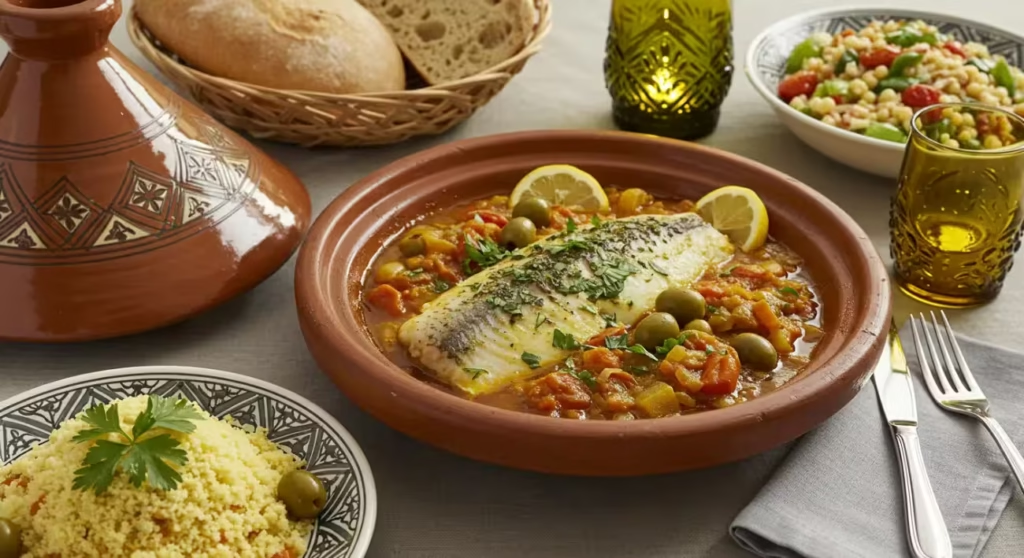
🎉 Presentation Tips for a Moroccan Feast
Serving tagine isn’t just about placing it on the table, it’s about creating an experience that reflects the heart of Moroccan hospitality. Here’s how you can make your dish feel like part of an authentic Moroccan feast:
- Serve Straight from the Tagine Pot: If you’ve used a traditional clay or ceramic tagine pot, bring it directly to the table. The tagine’s dome-shaped lid keeps the dish warm and steamy, while the base doubles as a serving platter. Removing the lid at the table not only retains heat but also allows the fragrant aromas to delight your guests.
- Family-Style Presentation: Moroccan meals are often served family-style, with everyone gathering around one dish. Place the tagine at the center of the table and provide spoons for sharing. This communal style of eating encourages conversation and connection.
- Add a Splash of Color: Garnish your tagine with freshly chopped cilantro or parsley for a vibrant touch. Add a few slices of preserved lemon or a handful of olives on top for a final flourish. The pops of yellow and green create an inviting visual contrast against the rich sauce and vegetables.
- Traditional Tableware: For an authentic experience, serve the meal with decorative Moroccan plates or bowls. Pair it with hand-woven placemats and small ceramic dishes for sides like olives or harissa.
🥗 Pairing Suggestions
A Moroccan fish tagine is wonderfully versatile and pairs beautifully with a variety of sides that complement its bold flavors. Here are some ideas:
- Couscous: Fluffy couscous is a classic accompaniment that soaks up the flavorful sauce from the tagine. You can serve it plain or enhance it with a drizzle of olive oil, toasted almonds, or golden raisins for a touch of sweetness.
- Fresh Bread: Moroccan meals often include khobz, a traditional crusty bread perfect for scooping up the sauce and vegetables. If you can’t find Moroccan bread, crusty baguettes or flatbreads work wonderfully too.
- Moroccan Salad: A refreshing side salad of diced cucumbers, tomatoes, red onion, and parsley dressed in lemon juice and olive oil provides a light and tangy contrast to the richness of the tagine.
- Spiced Mint Tea: For a true Moroccan experience, serve spiced mint tea alongside your meal. Its cooling properties balance the warmth of the spices in the tagine.
Pro Tip: Pairing the tagine with simple, fresh sides ensures the dish remains the star of the meal while adding variety to the table.
❄️ Storage and Reheating Tips
If you find yourself with leftovers (which is rare because this dish is so irresistible!), rest assured that Moroccan whiting fish tagine stores and reheats beautifully. Here’s how to keep it just as flavorful:
- Storing Leftovers:
- Refrigerator: Allow the tagine to cool completely before transferring it to an airtight container. Keep it in the fridge for 2 to 3 days.
- Freezer: For longer storage, place the cooled tagine in a freezer-safe container, leaving a little room at the top for expansion. You can store it in the freezer for a maximum of two months.
- Reheating Tips:
- Stovetop: If you have a tagine pot or a heavy-bottomed pan, reheat the dish over low heat. Add a splash of water or stock to maintain moisture, and cover to prevent drying out. Stir gently to avoid breaking up the fish fillets.
- Oven: Transfer the tagine to an oven-safe dish and cover it with foil. Reheat at 325°F (160°C) for about 20 minutes or until warmed through.
- Microwave: For smaller portions, use the microwave, but be cautious not to overheat, as it can dry out the fish. Use a microwave-safe dish, cover with a lid or damp paper towel, and heat in 30-second intervals.
- Refreshing the Dish: To bring back the fresh flavors, sprinkle some freshly chopped herbs or squeeze a bit of lemon juice over the reheated tagine before serving.
Pro Tip: Leftover tagine often tastes even better the next day, as the flavors have more time to meld together.
By focusing on thoughtful presentation, complementary pairings, and proper storage, you’ll ensure that every aspect of your tagine whiting fish recipe shines. For more Moroccan inspiration, take a look at our Authentic Tangia Recipe – a true culinary experience from Marrakech. You can also explore The Spruce Eats’ guide to Moroccan cuisine for more serving and pairing ideas from trusted culinary experts.
🐠 Why Whiting Fish Recipes Are a Must-Try
Whiting fish is an underappreciated gem in the world of seafood. Often overshadowed by its more famous counterparts, whiting deserves a place in your kitchen for its health benefits, versatility, and ability to shine in various dishes. If you’ve never considered using whiting in your meals, here’s why whiting fish recipes, especially a flavorful Moroccan tagine, are an absolute must-try.

💪 Health Benefits of Whiting Fish Recipes
Whiting is a lean, protein-rich fish that packs a powerful nutritional punch, making it an excellent choice for health-conscious eaters.
- Low in Fat, High in Protein: Whiting is a low-fat fish that provides a healthy source of protein. A 3-ounce serving offers around 20 grams of protein, essential for muscle repair, immune function, and overall bodily health.
- Rich in Omega-3 Fatty Acids: While not as high as fatty fish like salmon, whiting still provides a good amount of omega-3 fatty acids, which are known to reduce inflammation, promote heart health, and support brain function.
- Packed with Essential Vitamins and Minerals: Whiting is a great source of B vitamins, particularly B12, which is important for maintaining energy levels and a healthy nervous system. It also contains selenium, a mineral that supports thyroid function and acts as an antioxidant.
- Low in Calories: For those looking to maintain a healthy weight or improve their diet, whiting is a low-calorie choice that won’t add unnecessary fat to your meal.
By incorporating whiting into your recipes, you’re choosing a fish that’s not only delicious but also offers a range of nutritional benefits to enhance your diet.
🧑🍳 Versatility of Whiting Fish
While whiting fish is commonly associated with fish and chips or simple grilled fillets, it’s actually an incredibly versatile ingredient that can be used in a wide variety of dishes, both traditional and modern. Here are just a few ways you can get creative with whiting:
- Grilled Whiting: Marinate the fish in olive oil, lemon, and herbs before grilling it for a quick and healthy dinner. The delicate texture of the whiting fillet makes it perfect for grilling without falling apart.
- Whiting Fish Tacos: Flake the cooked whiting into soft tortillas and top with tangy slaw, salsa, and a drizzle of lime for a delicious taco night.
- Baked Whiting Fillets: For an easy weeknight meal, bake whiting fillets with breadcrumbs, garlic, and a dash of paprika for a crispy and flavorful outer layer.
- Whiting Fish Stew: Add whiting to a vegetable-based stew, where its mild flavor complements hearty root vegetables, tomatoes, and fresh herbs.
Of course, when it comes to Moroccan cuisine, whiting fish recipes is one of the most popular and mouthwatering ways to enjoy this versatile fish. But the possibilities are endless, whiting can be used in curries, soups, fish pies, and even fish cakes!
🌍 Moroccan Cuisine for All Seasons
One of the many wonderful things about Moroccan cuisine is that it seamlessly transitions between seasons. Whether it’s the heat of summer or the chill of winter, Moroccan dishes like tagine whiting fish recipes work beautifully throughout the year. Here’s why:
- Ideal for All Weather: In summer, the light, flaky texture of whiting makes it perfect for a fresh, aromatic fish tagine with preserved lemons and olives. On cooler days, the slow-cooked flavors of a rich tagine, infused with spices like cumin, coriander, and paprika, warm the soul and provide comfort. The versatility of the dish allows it to be enjoyed in all seasons, making it a staple in Moroccan homes year-round.
- Spices for Every Season: Moroccan tagines often include a wonderful array of spices, like saffron, turmeric, and cinnamon, that are rich in warmth, perfect for winter meals. But the bright notes of lemon and fresh herbs in the marinade lend the dish a refreshing touch ideal for summer.
- Flexible Ingredients: Because Moroccan fish tagine typically includes hearty vegetables like tomatoes, carrots, and potatoes, it can easily adapt to seasonal produce. Use fresh spring vegetables like zucchini or bell peppers in the warmer months, or root vegetables like sweet potatoes in colder months.
- Healthy and Satisfying: The use of whiting, vegetables, and herbs ensures that the tagine is nourishing, light yet filling, and packed with nutrients, making it the perfect dish for any time of year, whether you need something refreshing or a cozy comfort food.
Pro Tip: Moroccan tagine is often made for large gatherings, and because of its rich flavors, it can be served for multiple seasons and celebrations without ever feeling out of place
Whiting fish recipes are a nutrient-packed, versatile ingredient that enhances both the flavor and health benefits of any dish. Whether you’re preparing a rich tagine like our Stuffed Sardines Recipe or exploring new healthy dinner ideas, this humble fish brings surprising depth and comfort to the table. For more on the nutritional value of lean fish like whiting, check out Healthline’s guide to healthy fish choices.
✅ Conclusion
Creating a Moroccan tagine whiting fish recipes is a delightful culinary experience that allows you to immerse yourself in the bold, aromatic flavors of Morocco. From the initial marination of the fish in the vibrant chermoula to the slow-cooked perfection of the tagine, every step brings you closer to a meal that’s not only delicious but also nourishing. By following the step-by-step instructions and using fresh, high-quality ingredients, you can recreate this iconic dish right in your own kitchen.
To recap, here’s a quick overview of the steps involved:
- Marinate the whiting fish: First, prepare the chermoula marinade and coat the fish to infuse it with layers of flavor.
- Layer your ingredients in the tagine: Place the fish and vegetables in the tagine, creating a beautiful and well-seasoned foundation.
- Slow cook: Allow the tagine to cook at low heat, letting the spices and ingredients meld together for maximum flavor.
- Serve and enjoy: Garnish with fresh herbs, preserved lemons, and olives, and pair with couscous or Moroccan bread for a truly authentic experience.
We hope that after reading this post, you feel inspired to experiment with Moroccan spices and customize your tagine to your taste. Moroccan cuisine is all about balance, spicy, savory, and slightly sweet, and the beauty of this dish is that you can play with the proportions to suit your preferences. Don’t be afraid to add your personal touch with extra ingredients or spices that you love. Whether you prefer a spicier chermoula or a lighter fish tagine, the possibilities are endless.
Once you’ve made your tagine whiting fish recipes, we’d love to hear about your cooking experience. Share your results, tweaks, and photos with us in the comments below or tag us on social media to inspire others. We believe that food brings people together, and sharing your creations is part of the magic.
If you enjoyed this Moroccan whiting fish recipes tagine , be sure to explore other delicious Moroccan recipes on our blog. From savory meat tagines to fresh salads and fragrant couscous dishes, we have a wide range of recipes that capture the heart and soul of Moroccan cuisine. So, whether you’re a seasoned chef or a beginner in the kitchen, our collection will inspire you to try new flavors and expand your cooking repertoire.
Thank you for reading, and happy cooking! 🌿
❓ Frequently Asked Questions
1. Can I use a different type of fish instead of whiting?
Absolutely! While whiting is a great choice for this tagine due to its mild flavor and flaky texture, you can substitute it with other white fish like cod, haddock, or tilapia. Just be mindful that cooking times may vary slightly depending on the thickness of the fillets.
2. What is chermoula, and how do I use it in other dishes?
Chermoula is a fragrant Moroccan marinade made with a blend of fresh herbs, garlic, spices, and olive oil. It’s commonly used with fish, but it can also be used to marinate chicken, lamb, or vegetables. The marinade is incredibly versatile, try using it on grilled meats or roasted vegetables for an added burst of flavor.
3. Can I make whiting fish recipes ahead of time?
Yes, you can! Moroccan tagines often taste even better the next day after the flavors have had more time to meld together. Prepare the tagine as directed and store it in the refrigerator for up to 2-3 days. To reheat, gently warm it on the stove or in the oven, adding a splash of water if needed to maintain moisture.
4. Can I make this whiting fish recipes in a regular pot instead of a tagine?
While a traditional tagine pot is ideal for slow-cooking and adding a unique flavor, you can certainly make this recipe in a Dutch oven or heavy-bottomed pot. Just be sure to cook it on low heat to replicate the slow cooking method that helps develop the rich flavors of the dish.
5. What should I serve with my Moroccan whiting fish tagine?
Moroccan tagine whiting fish recipes pairs beautifully with a variety of sides. Classic options include couscous, which absorbs the flavorful sauce, or Moroccan khobz (bread) for dipping. You can also serve it with a refreshing Moroccan salad made of tomatoes, cucumbers, and fresh herbs, or a side of sautéed greens.
6. Is whiting fish a sustainable choice?
Whiting is generally considered a sustainable choice when sourced responsibly. However, sustainability can vary depending on where the fish is caught. Always check for certifications like the Marine Stewardship Council (MSC) label to ensure that your whiting fish is harvested in an environmentally responsible way.
7. Can I make this whiting fish recipes tagine with a slow cooker?
Certainly, you can modify the recipe to use a slow cooker. After marinating the whiting and preparing the vegetables, layer them in the slow cooker and cook on low for 3-4 hours. Keep in mind that a slow cooker might not produce the same crispy edges that a tagine pot can, but the flavors will still be rich and delicious.
If you have any other questions or want to share your own experience with this recipe, feel free to leave a comment below! We’re always happy to help and hear how you’re making this dish your own.

How to Create a Zesty Moroccan Feast with Whiting Fish Recipes
Equipment
- Tagine Pot (or Dutch Oven): The traditional Moroccan tagine pot is ideal for slow cooking and allowing the flavors to meld together. If you don’t have a tagine, a Dutch oven or any heavy-bottomed pot with a lid will work perfectly for this recipe.
- Mixing Bowls: For preparing the chermoula marinade and mixing the spices, herbs, and fish.
- Sharp Knife: A good sharp knife is essential for finely chopping the parsley, cilantro, garlic, and vegetables.
- Cutting Board: Use a sturdy cutting board for chopping and prepping the vegetables and fish.
- Measuring Spoons and Cups: To accurately measure out the spices, oil, and other ingredients.
- Wooden Spoon or Spatula:For gently stirring the ingredients and mixing them in the tagine.
- Citrus Juicer: If you prefer fresh lemon juice, a citrus juicer makes it easy to extract juice from your lemon.
- Tongs or Fish Turner: To carefully handle the fish fillets without breaking them while arranging them in the tagine.
- Lid for the Tagine or Pot: A tight-fitting lid is crucial for locking in the heat and moisture, ensuring the fish cooks slowly and evenly.
- Serving Platter or Bowl: For presenting the tagine once it’s cooked, serving it family-style for a traditional Moroccan experience.
Ingredients
- Ingredients:
- 4 whiting fish fillets or other white fish
- 2 tablespoons paprika
- 1 teaspoon ground cumin
- 1 teaspoon ground coriander
- 1 tablespoon chopped fresh parsley
- 1 tablespoon chopped fresh cilantro
- 3 garlic cloves minced
- 1 tablespoon lemon juice
- 3 tablespoons olive oil
- 1 teaspoon salt
- ½ teaspoon black pepper
- 1 large onion thinly sliced
- 2 carrots peeled and sliced
- 2 medium potatoes peeled and diced
- 2 tomatoes chopped
- 1 preserved lemon sliced
- 10-12 green olives optional
Instructions
- Instructions:
- Marinate the Fish: In a bowl, combine paprika, cumin, coriander, parsley, cilantro, garlic, lemon juice, olive oil, salt, and pepper. Rub this chermoula marinade all over the whiting fillets and let them marinate for at least 15-20 minutes.
- Prepare the Tagine: Heat the tagine or a heavy-bottomed pot over medium heat. Layer the sliced onions, carrots, and potatoes at the bottom of the tagine. Top with chopped tomatoes and preserved lemon slices.
- Add the Fish: Arrange the marinated fish fillets over the vegetables in the tagine. Pour any leftover marinade over the fish. Add olives on top if desired.
- Slow Cook: Cover the tagine with its lid and cook over low heat for 30-40 minutes, allowing the flavors to meld together and the fish to cook through.
- Serve: Once the fish is tender and the vegetables are soft, remove from heat. Garnish with fresh cilantro and serve hot.
Notes
- If you don’t have a tagine, you can use a Dutch oven or a large pot with a tight-fitting lid.
- Feel free to adjust the spices based on your taste. Add chili flakes for a little heat or more lemon for brightness.
- You can substitute whiting with cod, haddock, or tilapia if needed
Nutrition Information (per serving):
| Calories | 350 kcal |
| Protein | 30g |
| Carbs | 30g |
| Fat | 15g |
| Fiber | 6g |
| Sugar | 7g |
| Sodium | 600mg |
Stay connected and join me on social media for more delicious recipes, cooking tips, and inspiration! Follow along for updates, behind-the-scenes content, and mouthwatering food ideas. Let’s share the joy of cooking together!
📬 Join Our Moroccan Kitchen Newsletter!
Love Moroccan flavors? Don’t miss a single recipe! Subscribe to our newsletter and get the latest authentic tagine recipes, seasonal cooking tips, and exclusive Moroccan culinary insights—straight to your inbox. Whether you’re a home cook or a passionate food explorer, our newsletter is your weekly dose of inspiration from the heart of Moroccan cuisine.
📩 Join Our Moroccan Foodie Community
Get the best Moroccan tagine recipes and seasonal culinary tips straight to your inbox.
Clarifying Essential Terms and Ingredients
To help you better understand the ingredients and elements mentioned in this article, here are brief explanations of key terms commonly used in Moroccan cuisine:
Khobz
This traditional Moroccan bread is a round, flat loaf with a dense yet soft texture. Used to scoop up tagines, stews, and dips, khobz is a staple in every Moroccan household. Made with simple ingredients like flour, water, salt, and yeast, it embodies the communal and cultural traditions of Morocco.
Ras el Hanout
A hallmark of Moroccan spice blends, “Ras el Hanout” translates to “head of the shop,” representing the finest spices a merchant can offer. This versatile blend typically includes a mix of warming spices such as cinnamon, cumin, turmeric, and ginger, and is used to flavor iconic dishes like tagines and couscous.
Saffron
Revered as “the golden spice,” saffron is obtained from the fine, hand-harvested threads of the crocus flower, making it a rare and precious addition to any dish. It imparts a rich yellow color and a subtle, earthy aroma to Moroccan dishes, from tagines to desserts. Its labor-intensive harvesting process makes it one of the most valuable spices in the world.
💬 We’d Love to Hear from You!
Tried this Moroccan whiting fish recipes tagine? Let us know how it turned out in the comments below! Share your tips, adjustments, or even photos of your dish—we always enjoy seeing how you bring Moroccan flavors to life in your own kitchen. Your feedback inspires us and helps others on their cooking journey too!
